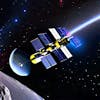S03E25: Russia's Angara A5 Triumph & TESS's Starry Standstill

**Episode Summary:**
Join Charlie on a cosmic voyage with today's episode of Astronomy Daily - The Podcast, as we delve into the latest space sector upheavals and triumphs. We'll celebrate the Angara A-5 rocket's ascent on its third attempt, a...
**Episode Summary:**
Join Charlie on a cosmic voyage with today's episode of Astronomy Daily - The Podcast, as we delve into the latest space sector upheavals and triumphs. We'll celebrate the Angara A-5 rocket's ascent on its third attempt, a testament to Russia's tenacity in space. We'll unpack the sudden suspension of NASA's TESS satellite and its implications for exoplanet discovery. Our journey also navigates the innovative solutions to the looming threat of orbital debris and the fascinating crater analysis research that's rewriting the histories of moons in our solar system. Plus, we'll offer a glimpse into ESA's meticulous preparations for the JUICE mission's future encounter with Jupiter's moon Callisto. Fasten your seatbelts for an episode that takes you from the Russian Far East to the outer reaches of our celestial neighborhood.
---
**Featured Topics:**
1. **Angara A-5's Triumphant Third Launch:** Witness the determination of Russia's space program as the Angara A-5 successfully launches, signaling a new chapter in the country's space endeavors.
2. **NASA's TESS Satellite Setback:** Explore the temporary halt of NASA's planet-hunting TESS and what it means for our search for Earth-like exoplanets.
3. **Combatting Orbital Debris:** Learn about the cutting-edge methods being developed to ensure the safe reentry of satellites and the preservation of our planet's orbital environment.
4. **Crater Analysis and Moon Dating:** Delve into the research that uses crater counting to determine the age of moons and uncover the dynamic history of our solar system.
5. **ESA's JUICE Mission Prepares for Callisto:** Get a sneak peek at how ESA's mission control is gearing up for the JUICE spacecraft's future flyby of Jupiter's intriguing moon, Callisto.
---
**Additional Information:**
For an uninterrupted cosmic experience, visit astronomydaily.io to explore our extensive library of episodes and sign up for our free newsletter. Stay connected with the Astronomy Daily community by following us on X (formerly known as Twitter) @AstroDailyPod.
This episode is brought to you with the support of NordPass - the password manager you need in your life. We use it every day and can't recommend it highly enough. Plus by using our special deal it won't cost very much money... details at www.bitesz.com/nordpass
---
**Closing Remarks:**
As we conclude this stellar journey, we thank you for your company on Astronomy Daily - The Podcast. May your curiosity continue to be fueled by the stars and the endless wonders of the universe. This is Charlie, your guide to the cosmic wonders, signing off. Until our next celestial rendezvous, remember to keep looking up.
---
**Host Sign-off:** Charlie: "Thank you for joining us on this interstellar exploration. Until the next episode, this is Charlie, signing off. Keep the cosmos in your thoughts and the spirit of discovery in your heart. Clear skies and Godspeed!"
For more visit www.astronomydaily.io
Become a supporter of this podcast: https://www.spreaker.com/podcast/astronomy-daily-the-podcast--5648921/support.
---
Episode Chapters
(00:00) Astronomy Daily podcast features the latest in space exploration and technology
(01:19) Russia's Angara a five rocket successfully launched on its third attempt
(03:32) NASA's transiting Exoplanet survey satellite temporarily paused operations
(05:48) New methods being put into practice to curb space debris...
AI Transcript
Astronomy Daily podcast features the latest in space exploration and technology
Charlie: Welcome to Astronomy Daily, the podcast where the cosmos comes into clearer view with each episode. Uh, today we'll delve into a selection of compelling stories shaking up the space sector. We'll discuss the Angara a five rocket's liftoff at the third attempt, an event that marks a significant moment for Russia amidst its recent space challenges. We'll also examine the sudden and mystifying shutdown of NASA's planet hunting test satellite. The implications of this unexpected hiccup in our search for exoplanets moving beyond Earth and its orbit, well explore innovative strategies to mitigate the ever growing issue of orbital debris, an invisible threat to our sustained ventures into space. Well then turn back the cosmic clock. Investigating the fascinating research using crater analysis to uncover the ancient stories of moons orbiting our solar systems, giant planets, and looking to future celestial encounters, well give you a sneak peek at ESA's advanced preparation for the juice missions flyby of, uh, Jupiter's enigmatic moon Callisto. Stay with us as we embark on this astronomical journey, unwrapping the secrets of the universe and bringing the latest in space exploration and technology straight to your ears.
Russia's Angara a five rocket successfully launched on its third attempt
Execution the astronomy daily podcast turning our gaze to the skies above the Russian Far east, the Angara a five rocket, Russia's aerospace hope, roared into the cosmos from the Vostokny Cosmodrome on its third scheduled launch attempt. After two scrubs due to pressing issues with a pressurising system and the engine control mechanism, the launch's success echoed as a definitive statement of the nation's resiliency in spacefaring pursuits. This milestone for the Angara a five, a behemoth engineered to dispatch heavy payloads into low Earth orbit, marks a pivotal stride in a sequence of rigorous testing needed to assert its reliability. The unveiling journey wasn't without its qualms, as the russian space agency Roscosmos aired the endeavour live, capturing the booster ascending to an altitude of 268 kilometres within the first 13 minutes. What we witnessed was not just the rocket's fiery departure, but also the manifestation of a long haul commitment. It's a path strewn with setbacks, including last year's ill fated lunar lander, which met with the lunar surface with an impact rather than with the soft landing planned. Development of the Angara a five has been painstaking, with a timeline punctuated by delays and spanning a decade riddled with only three prior liftoffs, one of which did not reach full fruition. Now the successful deployment of a test payload casts favourable light on the prospect of Moscow's ambition, a new bastion in orbit to rival the legacy of the International Space Station. The implications run deep. The prolific Angara a five is charting the course to elevate Russia's galactic blueprint, foreseeably playing a role in delivering the foundational blocks for a forthcoming orbital platform. As we consider this recent flight, we ponder not just the engineering triumph and the fiery spectacle of launch. We look toward an era where resoluteness and innovation may lead Roscosmos to new celestial frontiers. The saga of Angara a five becoming a crown jewel in their cosmic odyssey.
NASA's transiting Exoplanet survey satellite temporarily paused operations
The cosmos has its mysteries, and one of NASA's key tools in uncovering them has hit a minor snag. The transiting Exoplanet survey satellite known as TESS has temporarily paused its vigilant search of the heavens due to an unexpected shift into safe mode. It's an unexpected twist in the missions otherwise smooth journey since SpaceX lofted it to the stars in 2018. As NASA's frontline planet hunter, TEss has the vital job of scouting the skies for exoplanets orbiting distant stars, seeking worlds that resemble our own earth. The temporary shutdown occurred as TESs was performing routine operations, a, uh, hiccup in outer space that NASA's team is investigating to restore full functionality in the immediate future. Despite this pause, TEss, our cosmic sentry, remains in good health, poised to re engage in its stellar senses, taking duties shortly. What makes TEss's work so fascinating is its quest for planets that could potentially host life, building on the legacy of its predecessor, the renowned Kepler telescope. With a gaze that spans an area of the sky over 400 times larger than that watched by Kepler, TEss has been instrumental in identifying over 2400 candidate exoplanets, including a pair of super Earth a mere 33 light years away. During its mission, Tess has even contributed unexpected bonuses beyond its primary purpose. It caught sight of a brilliant gamma ray burst, the violent birth throes of a black hole highlighting the satellite's versatile role in our understanding of the universe. The temporary shutdown has certainly introduced suspense into Tess's narrative, a reminder of the fragility and complexity entailed in our explorations of the cosmos. Yet its track record, a, uh, treasury of knowledge about distant planets and the grandeur of spacetime events, assures us that Tess is more than a mere machine. Its a bridge to the vast potential of human discovery, a searchlight in the dark, charting paths to new worlds and universal secrets hitherto beyond our grasp. And so we await with eager anticipation the reawakening of Tess to continue its grand survey of the galactic seas, sailing once more under the banner of curiosity and wonder.
New methods being put into practice to curb space debris concerns
As we venture deeper into the cosmos, the issue of space debris becomes more pressing. Today, let's discuss some groundbreaking methods being put into practice to curb this growing concern, particularly concerning satellite reentry designs. Engineers and scientists are keenly aware that the remnants of our endeavors circling the earth pose risks both in space and upon reentry. At the University of Stuttgart's high enthalpy flow diagnostics group, remarkable tests are unfolding here. A reaction wheel, a device pivotal for adjusting satellites orientation, faces a rigorous trial within a plasma wind tunnel. This tunnel replicates the severe heat and speed of atmospheric reentry while the wheel itself is rotated, simulating the chaotic return journey of a satellite. Collins Aerospace in Germany has been at the forefront of these endeavors, making significant amendments to their Teldx reaction wheel. Their aim? To enhance what's known as its demizability, a term coined for ensuring the satellite can disintegrate in a controlled manner during reentry, thereby eliminating the possibility of space junk surviving its earthbound descent. This innovative approach to design for demise, or D 4D, was the focal point of this year's space Mechanisms workshop at the European Space Agency's Estec technical centre. This gathering, which brought together a constellation of over 130 industry and academic experts, zeroed in on the urgency to perfect satellite mechanisms that vanish completely upon re entering our atmosphere. The consequences of neglecting such technologies are stark, conjuring memories of past incidents where falling debris has come perilously close to causing casualties. It's imperative, therefore, that we consider either, um, guiding the satellite fragments to ensure a, uh, reduced ground footprint, or ensuring total disintegration where possible. New initiatives are already in motion. ESA and other industry heavyweights are, uh, developing spacecraft with the express purpose of capturing and safely deorbiting defunct satellites. This proactive stance underscores how essential specialised mechanisms will be in maintaining the long term sustainability of our orbital environments. As the frequency of satellite launches grows, it's ever important to adhere to stringent debris mitigation regulations. The safety of our increasingly busy skies isn't just a matter of outer space. It's about protecting the blue skies of our home planet as well.
The dating of moons within our solar system is an intricate puzzle
The astronomy Daily podcast the dating of moons within our solar system is an intricate puzzle that scientists are continuously striving to piece together. As the celestial dance of moons around Jupiter, Saturn, Uranus and Neptune carries on, researchers look to the time etched surfaces of these moons to unravel secrets of their age and origin. At the core of this research is the technique known as crater analysis the craters that spangle the moonscapes are, uh, not merely features for stunning visuals, but act as historical records. By counting these impact craters, scientists can estimate the age of the moon's surfaces in the early solar system. A frenetic ballet of cosmic debris created a tempestuous environment. When Neptune flung planetesimals through the solar system, it set off a chain reaction of bombardments, the evidence of which is clearest on the outer moons. A recent study, spearheaded by William Botka from the Southwest Research Institute, has made headway in dating the surfaces of 26 moons. Through meticulous modelling of bombardment frequencies and their resulting craters, the team aims to understand the timeline of impacts and the resultant reshaping of these celestial bodies. Their findings tell a tale of obliteration and rebirth. Early massive impacts have vanished, lost to subsequent extensive resurfacing processes. For instance, on moons like Iapetus and Oberon, we see surfaces that were formed only a few million years into the onslaught of interplanetary collisions. Larger moons present even younger skins, masquerading the true extent of their ancient scars. This research illuminates and endorses the prevailing theory that larger moons likely coalesced from circumplanetary disks akin to smaller scale planetary systems. Yet the absence of evidence from the tumultuous infancy of the solar system means a piece of the puzzle remains elusive. In pursuit of these enigmatic origins, future space missions equipped with advanced instruments are set to cast further light upon these distant realms. By harnessing gravity measurements and continuing the laborious task of crater counting, we hope to peel back layers of cosmic history to a time shortly after the dawn of our solar. In this endless journey through time and space, each crater holds the potential to unlock chapters of a narrative that spans billions of years beneath the silent gaze of those celestial sentinels, our solar system's moons.
European Space Agency's juice mission aims to explore Jupiter's moon Callisto
As we journey seven years into the future, the European Space Agency's juice mission orbits into our conversation now envisage the year 2031. A spacecraft named Juice soars past Jupiter's moon Callisto, a spectacle that promises to unveil the secrets of this cratered alien landscape. Teams tucked away at ESA's mission control have already set this celestial dance into motion, despite it being years ahead of us. Picture this. Operators, with their minds cast far across the solar system, maneuver a terrestrial replica of juice, an engineering model here on Earth. They simulate the actions juice will take millions of kilometres away, testing its autonomous navigation software to perfection. This preparation is crucial, as the immense distance to the Jupiter system means there's no time for a real time intervention from ground control, think of Callisto, this sphere of mystery floating in Juicer's path. With the vast communication delay, the guice probe must rely on its eyes and brain to lock its instruments onto features on Callisto, rotate and maintain a pointed gaze all autonomously. This would entail the spacecraft detecting where Callisto appears before it, identifying its surface landmarks, and adjusting its position accordingly to keep its sensors trained on them, all while slicing past at tremendous speeds. This isn't just a matter of sophisticated programming, though. It's about preparing for scenarios where the difference between monumental discovery and a fruitless pass could hinge on fractions of a degree. The ESA team's meticulous planning and execution must also ensure that during this delicate operation, nothing is left to chance. In this instance, it's not hyperbole to say that ESA's mission specialists are rehearsing a ballet of cosmic proportions, where every spin, every leap, every arc must be orchestrated without the conductor's baton. So when the day arrives for juice to embrace Callister's gravitational pull, we back on Earth can hope to receive a trophy of scientific insights that have been years in the making. And that, esteemed listeners, is how the future of space exploration is meticulously charted from the confines of our blue planet.
Thank you for listening to Astronomy daily podcast
As we draw to a close on today's journey through the cosmos, I want to take a moment to extend a heartfelt thank you for joining us here at Astronomy daily, the podcast your curiosity and passion for the stars and beyond make this exploration through the universe all the more exciting. If you're thirsty for more stellar content, I invite you to visit our website at astronomydaily IO. There you'll find a treasure trove of past episodes ripe for binging and bursting with astronomical wonders. Go ahead, dive into the archive and relive the highlights, or catch up on what you've missed while you're there. Don't miss out on the opportunity to subscribe to our free daily newsletter. It's your personal briefing on the latest happenings in space and astronomy, delivered right to your inbox. Be the first to know about breakthroughs, sightings, and cosmic events. And for those who like to keep their finger on the pulse of the social universe, follow us on x, previously known as Twitter. Um, just search for Astro Dailypod and make sure to hit that follow button to stay connected with the community of celestial enthusiasts. Thank you again for tuning in. And until next time, keep your eyes to the skies and your mind wide open to the wonders above. Clear skies and Godspeed. This is your host, Charlie, signing off the Astronomy daily podcast.
New to Astronomy Daily - The Podcast?
Here are some great episodes to start with.














